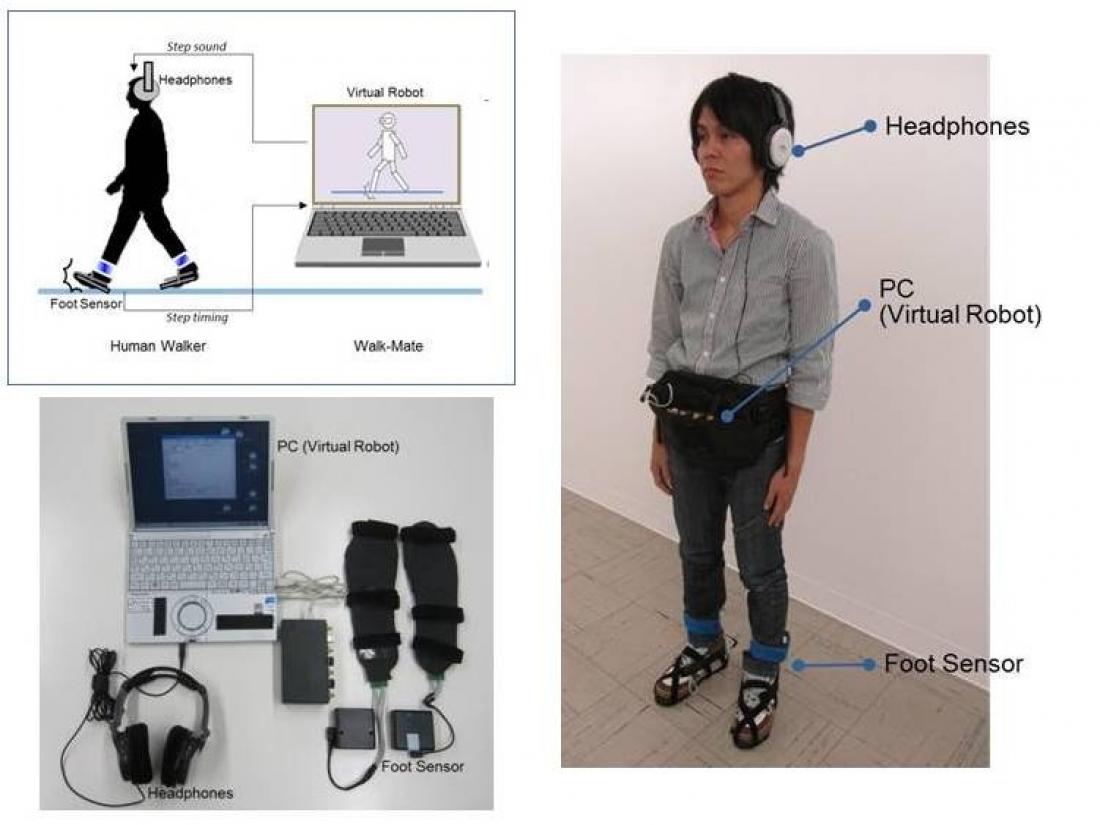Schematic illustration and components of the WalkMate system.
PRESS RELEASE
Source: Tokyo Institute of Technology, Center for Public Information
For immediate release: 27 August 2012
Tokyo Institute of Technology researchers develop the WalkMate System for improving the quality of life of Parkinson’s disease patients.
(Tokyo, 27 August 2012) Tokyo Tech ‘s Yoshihiro Miyake and colleagues have developed an innovative, non-invasive therapeutic intervention that may improve the mobility, stability, and quality of life of Parkinson’s disease patients.
The technology is also described in the August issue of Tokyo Institute of Technology Bulletin: http://www.titech.ac.jp/bulletin/index.html
The unintentional synchronizing of people’s gait as they walk together is a familiar phenomenon. Understanding the mechanisms behind this synchronization could help people with a disturbed gait, such as patients suffering from Parkinson’s disease. Research by Yoshihiro Miyake at the Department of Computational Intelligence and Systems Science at Tokyo Institute of Technology has helped to demystify the process and led to a new walking support device – ‘Walk Mate’.
Yoshihiro Miyake investigated coupled walking processes between a walking robot and a walking person. The study included people with a healthy gait and people suffering from Parkinson’s disease or hemiplegia due to brain infraction. He used the timing of the walking person as a sensory input for the robot and the sound of a walking rhythm as the robot’s output. An algorithm based on travelling wave dynamics controlled the timing difference between the Walk Mate’s input and output.
The study revealed how people adjust their pace in response to the robot’s audible output. Patients’ stride patterns were healthier using ‘Walk Mate’ and they reported a greater stability and “sense of togetherness” compared with more traditional walking aids that have a fixed rhythm. Further studies in collaboration with researchers at the Max Planck Institute for Human Cognitive and Brain Sciences and the Department of Neurology at Kanto Central Hospital have underlined the great potential of the device.
“Our approach offers a flexible, portable, low-cost, non-invasive therapeutic intervention that may improve the mobility, stability, and quality of life of Parkinson’s disease patients,” say the inventors.
----------------------
Further information:
Miwako Kato and Yukiko Tokida, Center for Public Information
Tokyo Institute of Technology, 2-12-1, Ookayama, Meguro-ku, Tokyo 152-8550, Japan
E-mail: [email protected]
URL: http://www.titech.ac.jp/english/
Tel: +81-3-5734-2975, Fax: +81-3-5734-3661
About Tokyo Institute of Technology
As one of Japan’s top universities, Tokyo Institute of Technology seeks to contribute to civilization, peace and prosperity in the world, and aims at developing global human capabilities par excellence through pioneering research and education in science and technology, including industrial and social management. To achieve this mission, we have an eye on educating highly moral students to acquire not only scientific expertise but also expertise in the liberal arts, and a balanced knowledge of the social sciences and humanities, all while researching deeply from basics to practice with academic mastery. Through these activities, we wish to contribute to global sustainability of the natural world and the support of human life.
Website: http://www.titech.ac.jp/english/



